A 250-Year Winter Minimum Temperature Reconstruction Based on Tree Rings from Luoji Mountain, Southwest China
Abstract
1. Introduction
2. Materials and Methods
2.1. Study Area
2.2. Tree-Ring Data and Chronology Development
2.3. Climate Data
2.4. Statistical Methods
3. Results
3.1. Relationship between Tree Growth and Climate Factors
3.2. Winter Mean Minimum Temperature Reconstruction
4. Discussion
4.1. Climate-Tree Growth Relationships
4.2. Spatial Representation of the Reconstruction
4.3. Possible Driving Mechanisms of the Winter Tmin
5. Conclusions
Author Contributions
Funding
Data Availability Statement
Conflicts of Interest
References
- IPCC. Climate Change 2021: The Physical Science Basis. Contribution of Working Group I to the Sixth Assessment Report of the Intergovernmental Panel on Climate; Masson-Delmotte, V., Zhai, P., Pirani, A., Connors, S.L., Péan, C., Berger, S., Caud, N., Chen, Y., Goldfarb, L., Gomis, M.I., et al., Eds.; Cambridge University Press: Cambridge, UK; New York, NY, USA, 2021. [Google Scholar]
- Zhu, L.J.; Zhang, Y.D.; Li, Z.S.; Guo, B.D.; Wang, X.C. A 368-year maximum temperature reconstruction based on tree-ring data in the northwestern Sichuan Plateau (NWSP), China. Clim. Past 2016, 12, 1485–1498. [Google Scholar] [CrossRef]
- Li, T.; Li, J.B. A 564-year annual minimum temperature reconstruction for the east central Tibetan Plateau from tree rings. Glob. Planet. Chang. 2017, 157, 165–173. [Google Scholar] [CrossRef]
- Song, Y.; Wang, C.; Linderholm, H.W.; Tian, J.; Shi, Y.; Xu, J.; Liu, Y. Agricultural adaptation to global warming in the Tibetan Plateau. Int. J. Environ. Res. Public Health 2019, 16, 3686. [Google Scholar] [CrossRef] [PubMed]
- You, Q.L.; Kang, S.C.; Aguilar, E.; Yan, Y.P. Changes in daily climate extremes in the eastern and central Tibetan Plateau during 1961–2005. J. Geophys. Res. 2008, 113, D07101. [Google Scholar] [CrossRef]
- Fritts, H.C. Tree Rings and Climate; Academic Press: New York, NY, USA, 1976. [Google Scholar]
- Schweingruber, F.H. Tree Rings and Environment Dendroecology; Paul Haupt Publishers: Bern, Switzerland, 1996. [Google Scholar]
- Shao, X.M. Advancements in Dendrochronology. Quat. Sci. 1997, 17, 265–271. [Google Scholar]
- Gou, X.H.; Deng, Y.; Chen, F.H.; Yang, M.X.; Fang, K.Y.; Gao, L.L.; Yang, T.; Zhang, F. Tree ring based streamflow reconstruction for the upper Yellow River over the past 1234 years. Chin. Sci. Bull. 2010, 55, 4179–4186. [Google Scholar] [CrossRef]
- Peng, J.F.; Liu, Y.Z.; Wang, T. A tree-ring record of 1920’s–1940’s droughts and mechanism analyses in Henan Province. Acta Ecol. Sin. 2014, 34, 3509–3518. [Google Scholar]
- Duan, J.P.; Wang, L.L.; Li, L.; Chen, K.L. Temperature variability since A.D. 1837 inferred from tree-ring maximum density of Abies fabric in Gongga Mountains, China. Chin. Sci. Bull. 2010, 55, 1036–1042. [Google Scholar] [CrossRef]
- Li, Z.S.; Liu, G.H.; Zhang, Q.B.; Hu, S.J.; Liu, X.L.; He, F. Tree ring reconstruction of summer temperature variations over the past 159 years in Wolong National Natural Reserve, western Sichuan, China. Chin. J. Plant Ecol. 2010, 34, 628–641. [Google Scholar]
- Yu, S.L.; Yuan, Y.J.; Wei, W.S.; Zhang, T.W.; Shang, H.M.; Chen, F. Reconstructed Mean Temperature in Mearkang, West Sichuan in July and Its Detection of Climatic Period Signal. Plateau Meteorol. 2012, 31, 193–200. [Google Scholar]
- Xiao, D.M.; Qin, N.S.; Li, J.J.; Li, Y.Y. Variations of June air temperature derived from tree-ring records in 1713–2010 in Jinchuan, west Sichuan Plateau, China. Adv. Clim. Chang. Res. 2013, 9, 252–257. [Google Scholar]
- Deng, Y.; Gou, X.H.; Gao, L.L.; Yang, T.; Yang, M.X. Early summer temperature variations over the past 563 yr inferred from tree rings in the Shaluli Mountains, southeastern Tibet Plateau. Quat. Res. 2014, 81, 513–519. [Google Scholar] [CrossRef]
- Li, J.J.; Shao, X.M.; Li, Y.Y.; Qin, N.S. Annual temperature recorded in tree-ring from Songpan region. China Sci. Bull. 2014, 59, 1446–1458. [Google Scholar]
- Xiao, D.M.; Qin, N.S.; Huang, X.M. A 325-year reconstruction of July–August mean temperature in the north of west Sichuan derived from tree-ring. Quat. Sci. 2015, 35, 1134–1144. [Google Scholar]
- Xiao, D.M.; Qin, N.S.; Li, J.J.; Li, Y.Y.; Mu, L. Change of mean temperature from July to September in northeast of western Sichuan Plateau based tree-ring. Plateau Meteorol. 2015, 34, 762–770. [Google Scholar]
- Qin, N.S.; Shi, X.H.; Shao, X.M.; Wang, Q.C. Average maximum temperature change recorded by tree rings in west Sichuan Plateau. Plateau Mt. Meteorol. Res. 2008, 28, 18–23. [Google Scholar]
- Xiao, D.M.; Qin, N.S.; Li, J.J.; Li, Y.Y. Change of mean maximum temperature in July during 1506–2008 in Seda of west Sichuan Plateau according to reconstructed tree-ring series. J. Desert Res. 2013, 33, 1536–1543. [Google Scholar]
- Shao, X.M.; Fan, J.M. Past climate on west Sichuan Plateau as reconstructed from ring-widths of dragon spruce. Quat. Sci. 1999, 1, 81–89. [Google Scholar]
- Song, H.M.; Liu, Y.; Ni, W.M.; Cai, Q.F.; Sun, J.Y.; Ge, W.B.; Xiao, W.Y. Winter mean lowest temperature derived from tree-ring width in Jiuzhaigou region, China since 1750 A. D. Quat. Sci. 2007, 27, 486–491. [Google Scholar]
- Yu, S.L.; Yuan, Y.J.; Wei, W.S.; Shang, H.M.; Zhang, T.W.; Chen, F.; Zhang, R.B. Reconstruction of minimum temperature field in June-July during 1787–2005 in the west Sichuan Plateau. J. Desert Res. 2012, 32, 1010–1016. [Google Scholar]
- Xie, C.S.; Li, J.J.; Gao, Y.Y.; Shi, S.L.; Peng, P.H.; Yang, X.; Feng, W.N. Tree-ring width based autumn and winter mean temperature reconstruction and its variation over the past 137 years in southwestern Sichuan Province. Quat. Sci. 2020, 40, 252–263. [Google Scholar]
- Holmes, R.L. Computer-assisted quality control in tree-ring dating and measurement. Tree-Ring Bull. 1983, 43, 69–78. [Google Scholar]
- Cook, E.R.; Kairiukstis, L.A. Methods of Dendrochronology: Applications in the Environmental Sciences; Kluwer: Dordrecht, The Netherlands, 1990. [Google Scholar]
- Cook, E.R.; Peters, K. Calculating unbiased tree-ring indices for the study of climatic and environmental change. Holocene 1997, 7, 361–370. [Google Scholar] [CrossRef]
- Wigley, T.M.L.; Briffa, K.R.; Jones, P.D. On the average value of correlated time-series, with applications in dendroclimatology and hydrometeorology. J. Clim. Appl. Meteorol. 1984, 23, 201–213. [Google Scholar] [CrossRef]
- Biondi, F.; Waikul, K. Dendroclim2002: A C ++ program for statistical calibration of climate signals in tree-ring chronologies. Comput. Geosci. 2004, 30, 303–311. [Google Scholar] [CrossRef]
- Michaelsen, J. Cross-validation in statistical climate forecast models. J. Clim. Appl. Meteorol. Climatol. 1987, 26, 1589–1600. [Google Scholar] [CrossRef]
- Olson, D.; Delen, D. Advanced Data Mining Techniques; Springer: Berlin, Germany, 2008. [Google Scholar]
- Mann, M.E.; Lees, J.M. Robust estimation of background noise and signal detection in climatic time series. Clim. Chang. 1996, 33, 409–445. [Google Scholar] [CrossRef]
- Torrence, C.; Compo, G.P. A practical guide to wavelet analysis. Bull. Am. Meteorol. Soc. 1998, 79, 61–78. [Google Scholar] [CrossRef]
- Harris, I.; Osborn, T.J.; Jones, P.; Lister, D. Version 4 of the CRU TS monthly high-resolution gridded multivariate climate dataset. Sci. Data 2020, 7, 109. [Google Scholar] [CrossRef]
- Kennedy, J.J.; Rayner, N.A.; Smith, R.O.; Saunby MParker, D.E. Reassessing biases and other uncertainties in sea-surface temperature observations since 1850 part 1: Measurement and sampling errors. J. Geophys. Res. 2011, 116, D14103. [Google Scholar] [CrossRef]
- Li, X.X.; Liang, E.; Gricar, J.; Prislan, P.; Rossi, S.; Cufar, K. Age dependence of xylogenesis and its climatic sensitivity in Smith fir on the south-eastern Tibetan Plateau. Tree Physiol. 2013, 33, 48–56. [Google Scholar] [CrossRef] [PubMed]
- Jin, X.; Xu, Q.; Liu, S.R.; Jiang, C.Q. Responses of the Tree-Ring of Abies faxoniana and Tsuga chinensis to Climate Factors in Sub-Alpine in Western Sichuan. Sci. Silvae Sin. 2013, 49, 21–26. [Google Scholar]
- Shi, S.Y.; Li, J.B.; Shi, J.F.; Zhao, Y.S.; Huang, G. Three centuries of winter temperature change on the southeastern Tibetan Plateau and its relationship with Atlantic Multidecadal Oscillation. Clim. Dyn. 2017, 49, 1305–1319. [Google Scholar] [CrossRef]
- Pallardy, S.G.; Kozlowski, T.T. Physiology of Woody Plants; Elsevier: Amsterdam, The Netherlands; Boston, MA, USA, 2008. [Google Scholar]
- Li, J.X.; Li, J.B.; Li, T.; Au, T.F. Tree growth divergence from winter temperature in the Gongga Mountains, southeastern Tibetan Plateau. Asian Geogr. 2020, 37, 1–15. [Google Scholar] [CrossRef]
- Li, J.X.; Li, J.B.; Li, T.; Au, T.F. 351-year tree ring reconstruction of the Gongga Mountains winter minimum temperature and its relationship with the Atlantic Multidecadal Oscillation. Clim. Chang. 2021, 165, 49. [Google Scholar] [CrossRef]
- Körner, C. Alpine Treelines: Functional Ecology of the Global High Elevation Tree Limits; Springer: Berlin, Germany, 2012. [Google Scholar]
- Gou, X.H.; Chen, F.H.; Jacoby, G.C.; Cook, E.R.; Yang, M.X.; Peng, J.F.; Zhang, Y. Rapid tree growth with respect to the last 400 years in response to climate warming, northeastern Tibetan Plateau. Int. J. Climatol. 2007, 27, 1497–1503. [Google Scholar] [CrossRef]
- Liang, E.Y.; Wang, Y.F.; Xu, Y.; Liu, B.; Shao, X.M. Growth variation in Abies georgei var. smithii along altitudinal gradients in the Sygera Mountains, southeastern Tibetan Plateau. Tree 2010, 24, 363–373. [Google Scholar] [CrossRef]
- Wang, J.L.; Yang, B.; Qin, C.; Kang, S.Y.; He, M.H.; Wang, Z.Y. Tree-ring inferred annual mean temperature variations on the southeastern Tibetan Plateau during the last millennium and their relationships with the Atlantic Multidecadal Oscillation. Clim. Dyn. 2014, 43, 627–640. [Google Scholar] [CrossRef]
- Liang, H.X.; Lyu, L.X.; Wahab, M. A 382-year reconstruction of August mean minimum temperature from tree-ring maximum latewood density on the southeastern Tibetan Plateau, China. Dendrochronologia 2016, 37, 1–8. [Google Scholar] [CrossRef]
- Liu, S.Y.; Ding, Y.J.; Li, J.; Shangguan, D.H.; Zhang, Y. Glaciers in response to recent climate warming in Western China. Quat. Sci. 2006, 26, 762–771. [Google Scholar]
- Li, Z.X.; He, Y.Q.; Jia, W.X.; Pang, H.X.; Yuan, L.L.; Ning, B.Y.; Liu, Q.; He, X.Z.; Song, B.; Zhang, N.N. Response of “Glaciers-Runoff” system in a typical temperature-glacier, Hailuogou glacier in Gongga Mountain of China to global change. Sci. Geogr. Sin. 2008, 28, 229–234. [Google Scholar]
- Li, Z.X.; He, Y.Q.; Jia, W.X.; Pang, H.X.; He, X.Z.; Wang, S.J.; Zhang, N.N.; Zhang, W.J.; Liu, Q.; Xin, H.J. Changes in Hailuogou glacier during the recent 100 years under global warming. J. Glaciol. Geocryol. 2009, 31, 75–81. [Google Scholar]
- Stothers, R.B. The great Tambora eruption in 1815 and its aftermath. Science 1984, 224, 1191–1198. [Google Scholar] [CrossRef] [PubMed]
- Wang, S.W.; Ye, J.L.; Gong, D.Y. Climate in China during the little ice age. Quat. Sci. 1998, 18(1), 54–64. [Google Scholar]
- Yang, B. Spatial and temporal patterns of climate variations over the Tibetan Plateau during the period 1300–2010. Quat. Sci. 2012, 32, 81–94. [Google Scholar]
- Mantua, N.J.; Hare, S.R.; Zhang, Y.; Wallace, J.M.; Francis, R.C. A Pacific interdecadal climate oscillation with impacts on salmon production. Bull. Amer. Meteor. Soc. 1997, 78, 1069–1079. [Google Scholar] [CrossRef]
- Gray, S.T.; Graumlich, L.J.; Betancourt, J.L.; Pederson, G.T. A tree-ring based reconstruction of the Atlantic Multidecadal Oscillation since 1567 A.D. Geophys. Res. Lett. 2004, 31, L12205. [Google Scholar] [CrossRef]
- Trenberth, K.E.; Shea, D.J. Atlantic hurricanes and natural variability in 2005. Geophys. Res. Lett. 2006, 33, L12704. [Google Scholar] [CrossRef]
- Mann, M.E.; Zhang, Z.; Rutherford, S.; Bradley, R.S.; Hughes, M.K.; Shindell, D.; Ammann, C.; Faluvegi, G.; Ni, F. Global Signatures and Dynamical Origins of the Little Ice Age and Medieval Climate Anomaly. Science 2009, 326, 1256–1260. [Google Scholar] [CrossRef]
- Keyimu, M.; Li, Z.S.; Zhang, G.S.; Fan, Z.X.; Wang, X.C.; Fu, B.J. Tree ring–based minimum temperature reconstruction in the central Hengduan Mountains, China. Theor. Appl. Climatol. 2020, 141, 359–370. [Google Scholar] [CrossRef]
- Keyimu, M.; Li, Z.S.; Liu, G.H.; Fu, B.J.; Fan, Z.X.; Wang, X.C.; Wu, X.C.; Zhang, Y.D.; Halik, U. Tree-ring based minimum temperature reconstruction on the southeastern Tibetan Plateau. Quat. Sci. Rev. 2021, 251, 106712. [Google Scholar] [CrossRef]
- Fang, K.Y.; Guo, Z.T.; Chen, D.L.; Wang, L.; Dong, Z.P.; Zhou, F.F.; Zhao, Y.; Li, J.B.; Li, Y.J.; Cao, X.G. Interdecadal modulation of the Atlantic Multi-decadal Oscillation (AMO) on southwest China’s temperature over the past 250 years. Clim. Dyn. 2019, 52, 2055–2065. [Google Scholar] [CrossRef]
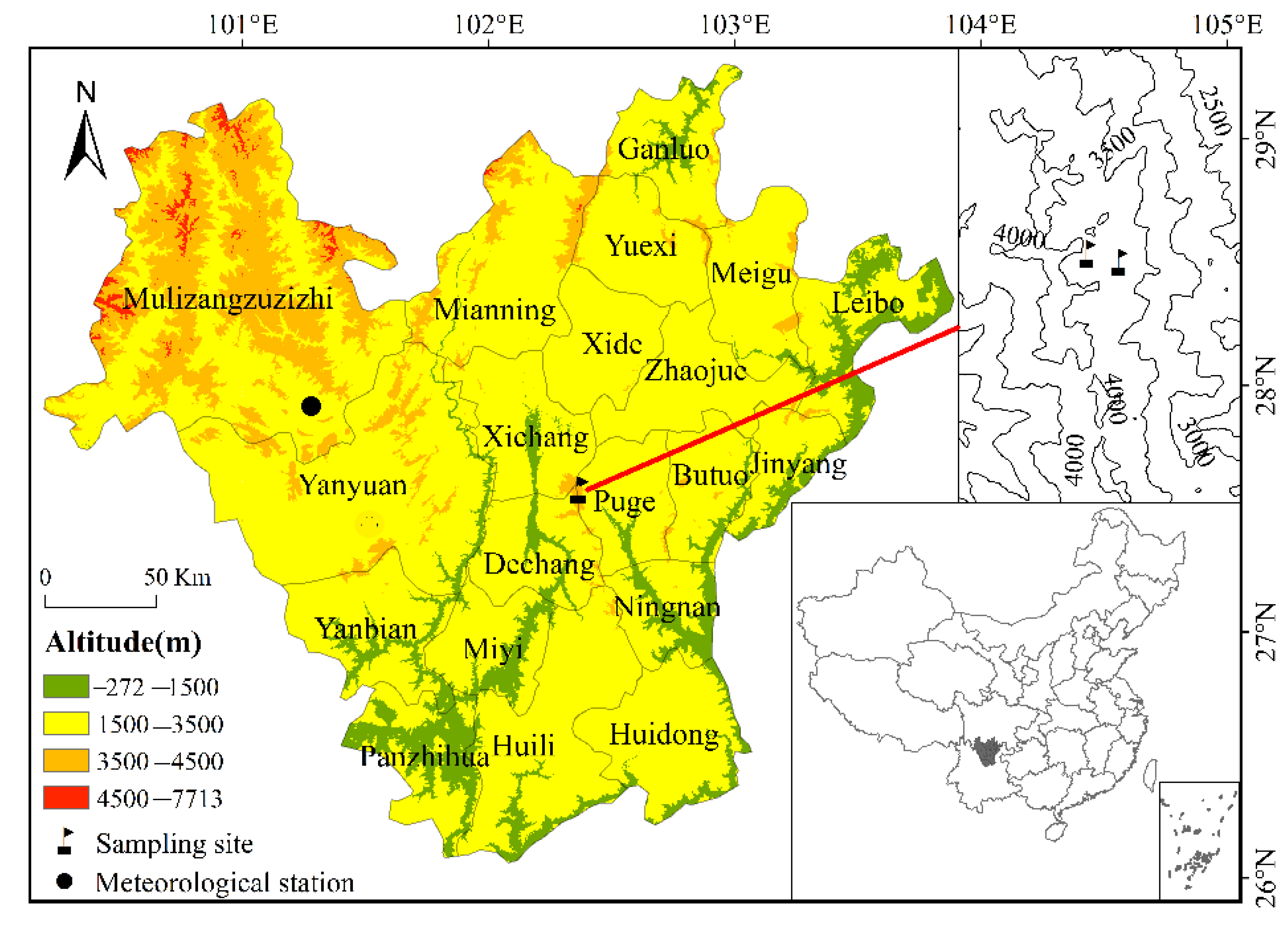

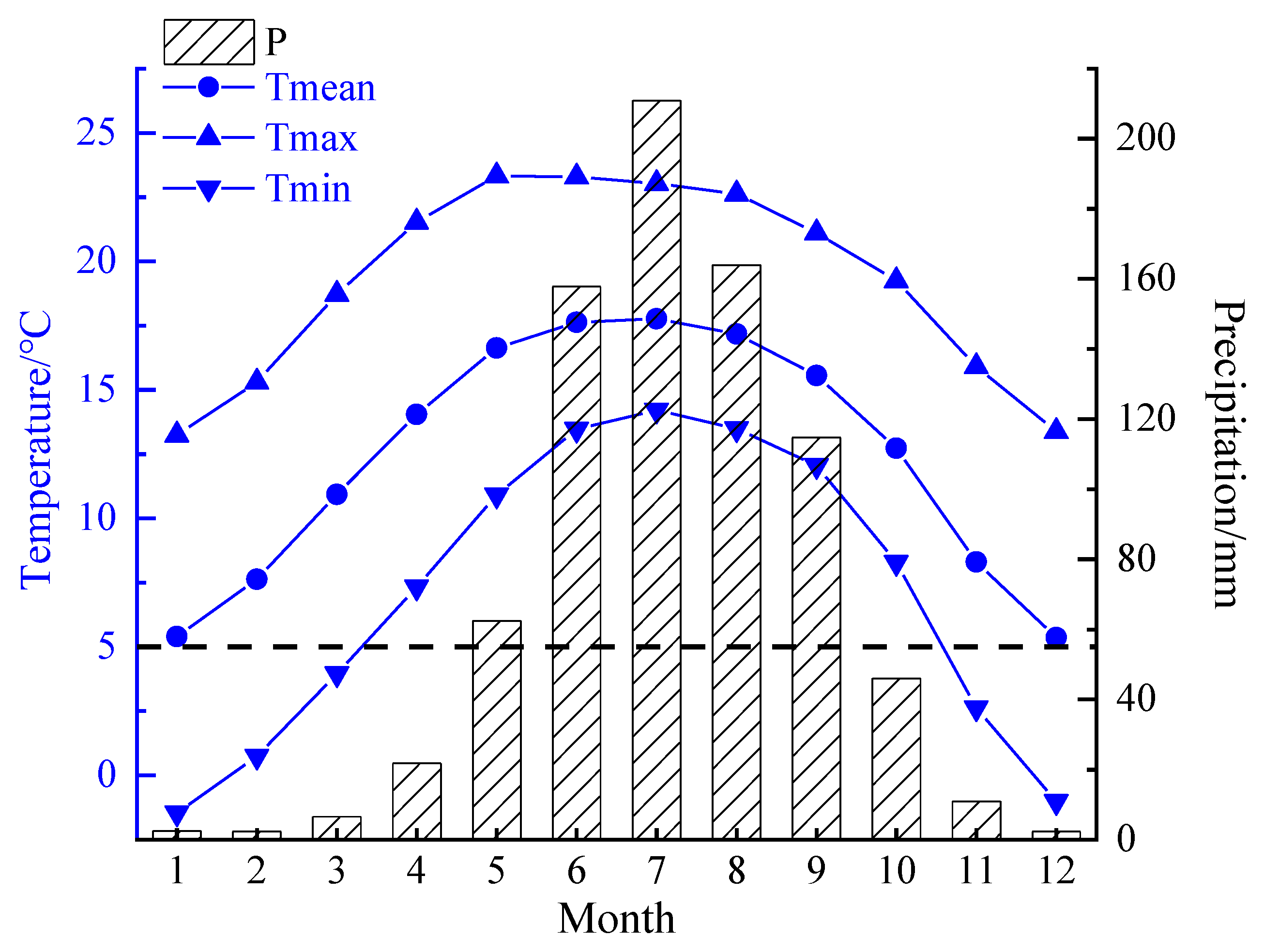
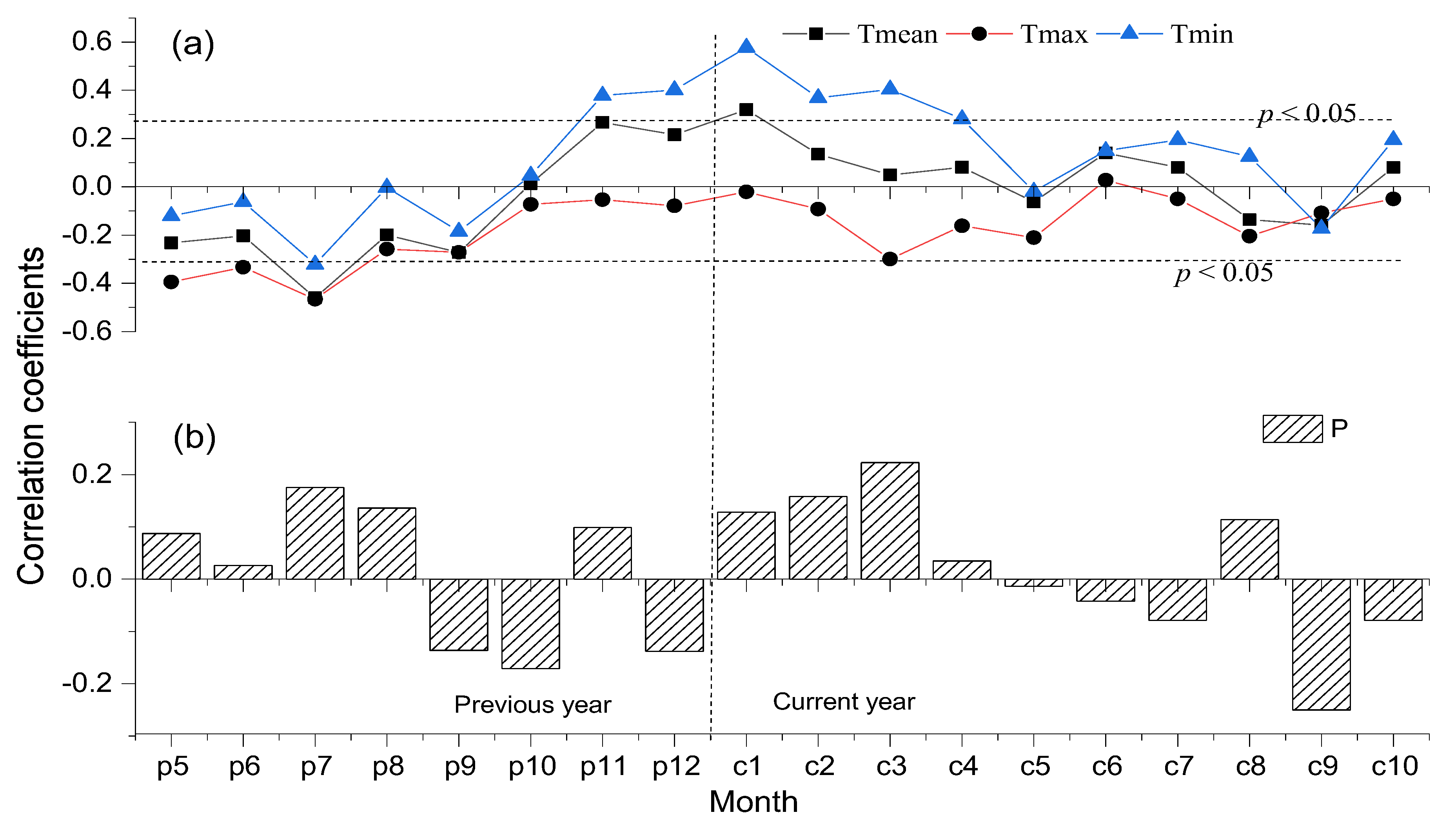
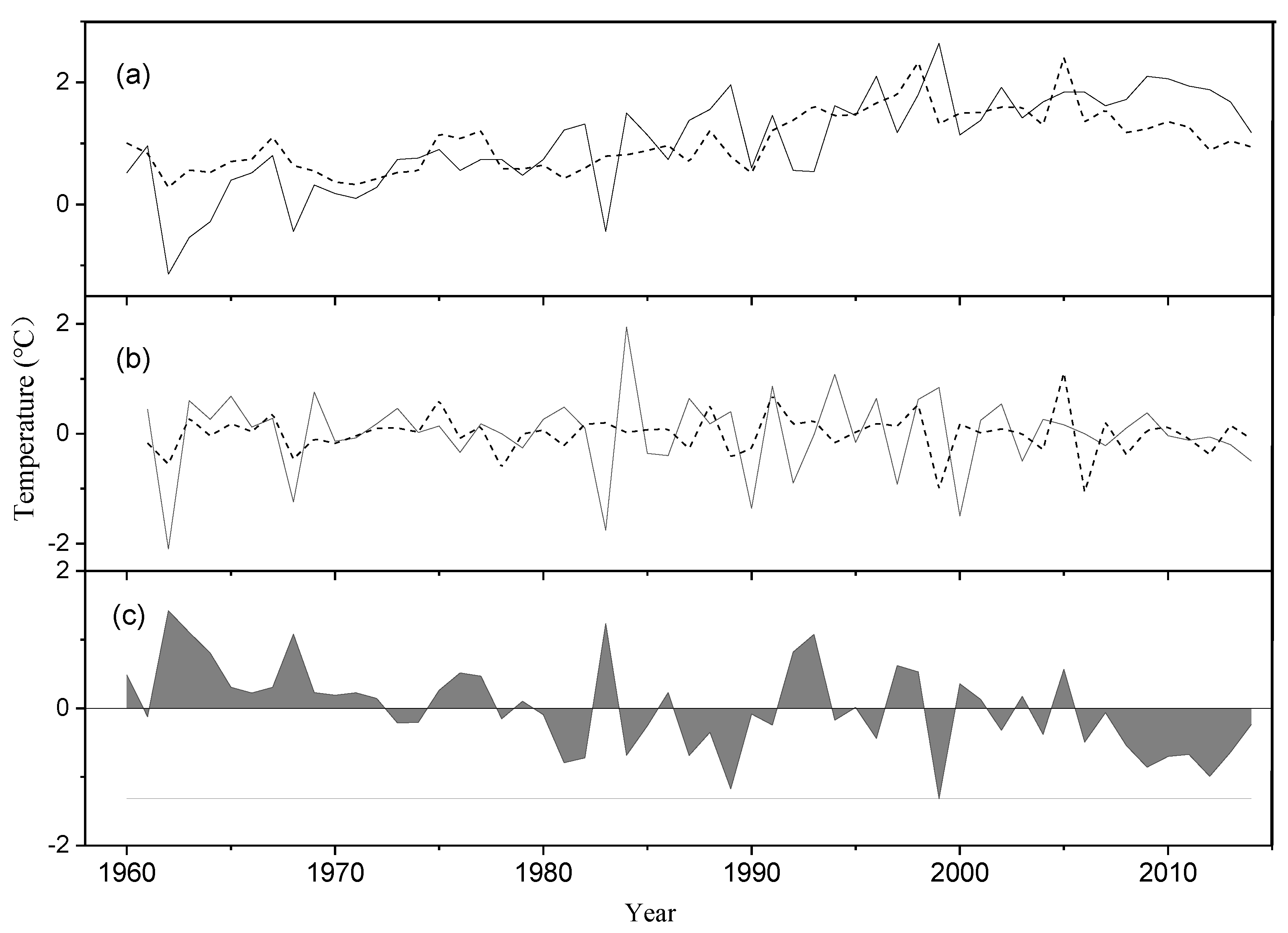
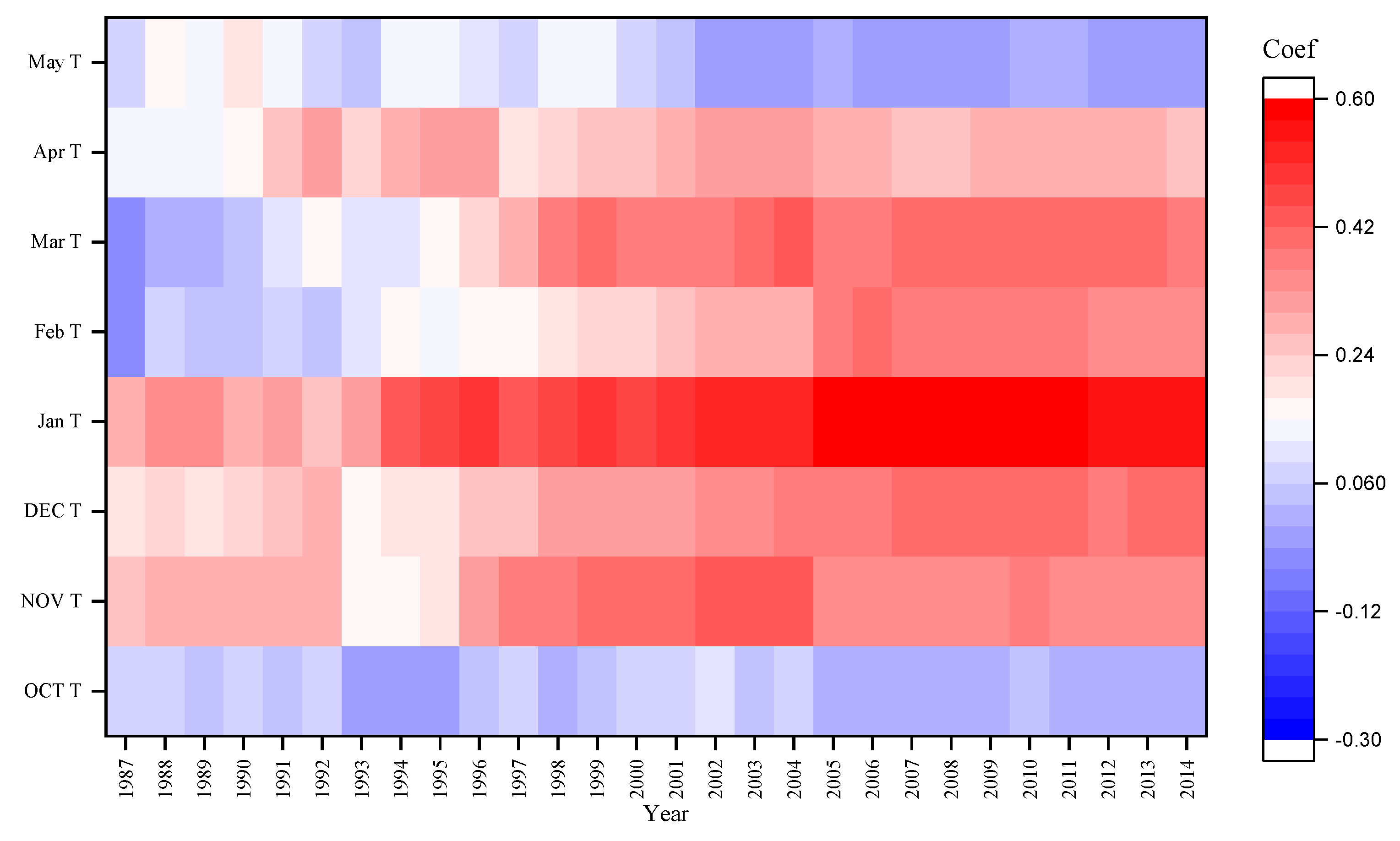
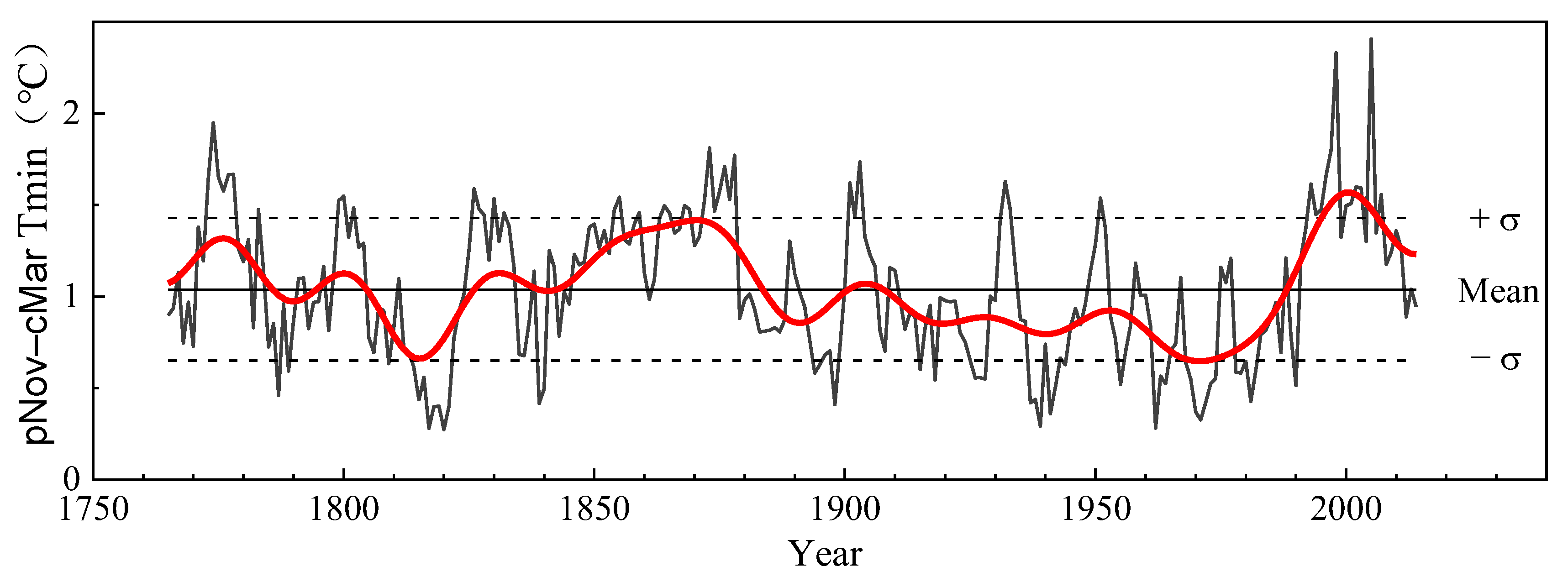

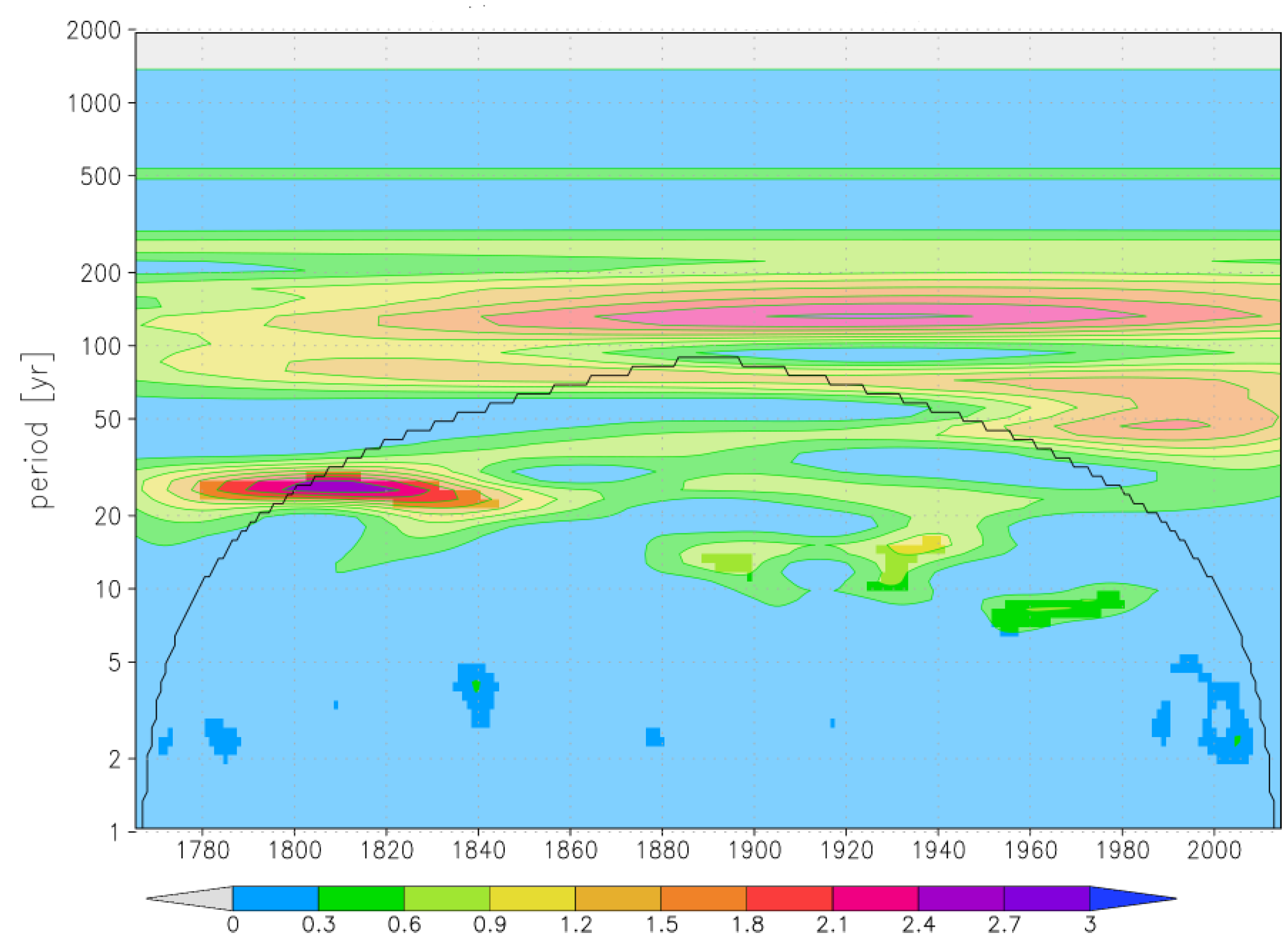
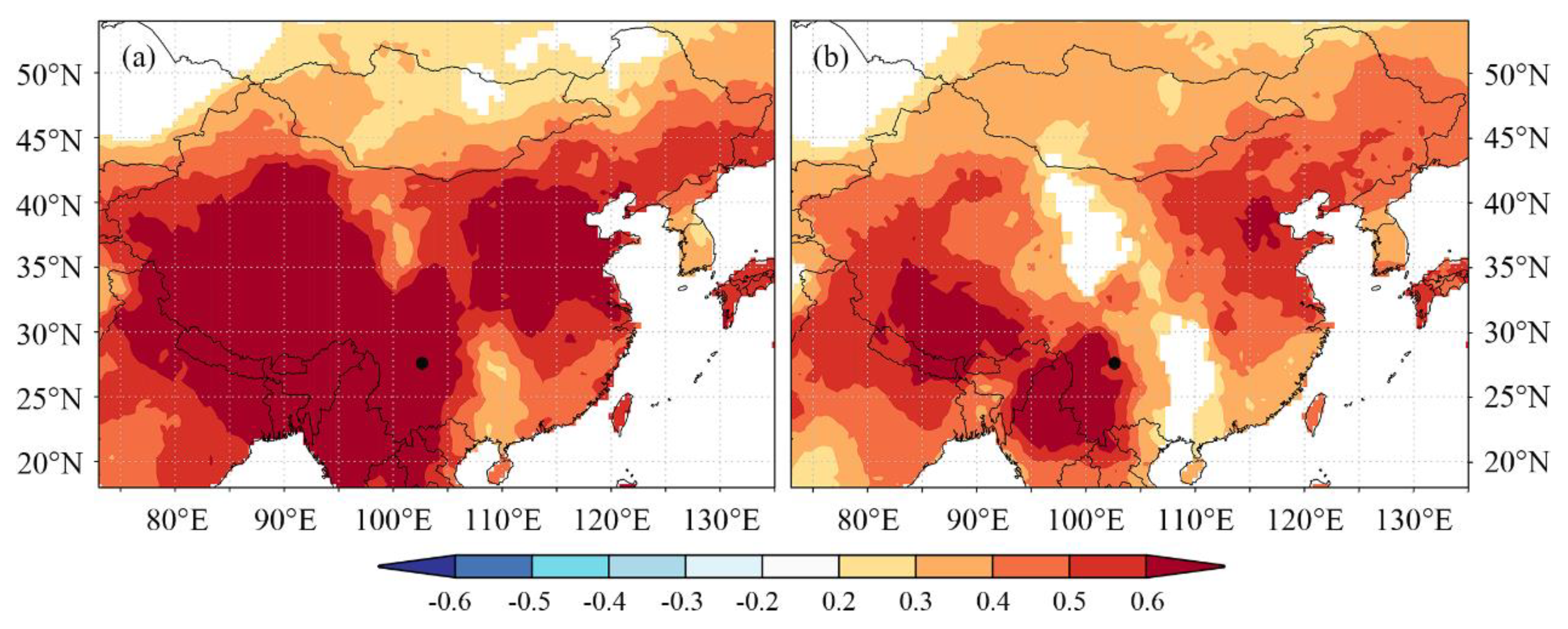


| Site Code | Latitude (N) | Longitude (E) | Elevation (m) | Number (Cores/Trees) | Time Span (AD) |
|---|---|---|---|---|---|
| LJH | 27°34′24.4″ | 102°22′28.4″ | 3890 | 70/33 | 1638~2014 |
| LJS | 27°34′32.7″ | 102°21′49.6″ | 3890 | 68/33 | 1673~2014 |
| Statistics | STD |
|---|---|
| Samples (core/tree) | 138/66 |
| Mean sensitivity (MS) | 0.121 |
| Standard deviation (SD) | 0.193 |
| Time span (year) | 1638~2014 |
| Time span with EPS > 0.85 (year) | 1765~2014 |
| Common period (year) | 1904~2014 |
| Mean inter-series correlation (R1) | 0.149 |
| Mean correlation within a tree (R2) | 0.611 |
| Mean correlation between trees (R3) | 0.145 |
| First-order autocorrelation (AC1) | 0.777 |
| Signal-to-noise ratio (SNR) | 21.032 |
| Expressed population signal (EPS) | 0.955 |
Disclaimer/Publisher’s Note: The statements, opinions and data contained in all publications are solely those of the individual author(s) and contributor(s) and not of MDPI and/or the editor(s). MDPI and/or the editor(s) disclaim responsibility for any injury to people or property resulting from any ideas, methods, instructions or products referred to in the content. |
© 2023 by the authors. Licensee MDPI, Basel, Switzerland. This article is an open access article distributed under the terms and conditions of the Creative Commons Attribution (CC BY) license (https://creativecommons.org/licenses/by/4.0/).
Share and Cite
Peng, J.; Li, J.; Li, J.; Li, T. A 250-Year Winter Minimum Temperature Reconstruction Based on Tree Rings from Luoji Mountain, Southwest China. Forests 2023, 14, 1555. https://doi.org/10.3390/f14081555
Peng J, Li J, Li J, Li T. A 250-Year Winter Minimum Temperature Reconstruction Based on Tree Rings from Luoji Mountain, Southwest China. Forests. 2023; 14(8):1555. https://doi.org/10.3390/f14081555
Chicago/Turabian StylePeng, Jianfeng, Jinbao Li, Jingru Li, and Teng Li. 2023. "A 250-Year Winter Minimum Temperature Reconstruction Based on Tree Rings from Luoji Mountain, Southwest China" Forests 14, no. 8: 1555. https://doi.org/10.3390/f14081555
APA StylePeng, J., Li, J., Li, J., & Li, T. (2023). A 250-Year Winter Minimum Temperature Reconstruction Based on Tree Rings from Luoji Mountain, Southwest China. Forests, 14(8), 1555. https://doi.org/10.3390/f14081555






